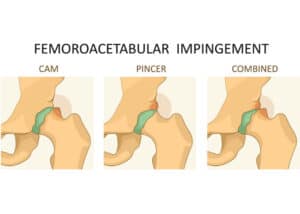Acetabuloplasty (Pincer Impingement)/Femoroacetabular Impingement (FAI) Surgeon

Have you been diagnosed with an abnormality in the hip bone called Femoroacetabular Impingement or FAI? FAI is a condition which causes pain, pinching and eventually damage to the cartilage of the hip. FAI and hip impingement surgeon Dr. Jeff Padalecki provides diagnosis and both surgical and nonsurgical treatment options for patients in Austin who have FAI or other forms of hip impingement including pincer impingement. Contact Dr. Padalecki’s team today!
Acetabuloplasty as a Pincer Impingement Treatment
Femoroacetabular impingement (FAI) is a condition where abnormal contact occurs between the bones of the hip. This abnormality commonly affects the hip joint in young and middle-aged adults who are involved in repetitive sports. The ball (femoral head) can impact the socket (acetabulum) and lead to degeneration within the joint. FAI has different names depending on what part of the hip has a bony abnormality. For example, pincer impingement occurs when extra bone extends out over the normal rim of the acetabulum. Acetabuloplasty, a surgical pincer impingement treatment, may be recommended by Dr. Jeff Padalecki, Austin, Round Rock, and Cedar Park, Texas communities orthopedic hip surgeon, in severe cases of pincer impingement.
What Causes Pincer Impingement?
Pincer impingement occurs when the abnormality involves the acetabular side of the joint. This condition creates over-coverage of the joint because the acetabulum is too deep and extends beyond the normal boundaries, or is mal-rotated. This results in the labrum becoming trapped between the femoral head and neck with motion of the hip. Over time, the labrum will tear and the underlying articular cartilage will be damaged.
The majority of patients with femoroacetabular impingement are diagnosed to have a mixed type, showing symptoms and traits of both pincer and cam (involving the femoral side of the hip joint) impingement.

How Is FAI Treated?
In the past decade, much has been learned about how to treat FAI. After conducting a thorough examination, Dr. Padalecki will assess if non-surgical techniques will work to treat the condition. This usually involves rest, activity modification and physical therapy to strengthen the core muscles around the hip. Injections may also be used for diagnostic and therapeutic purposes. If a patient continues to have ongoing hip pain, then a surgical pincer impingement treatment is usually recommended to correct the bony conflict.
How is an Acetabuloplasty Performed?
If surgery is indicated, Dr. Padalecki will perform arthroscopic hip surgery to correct the impingement. An acetabuloplasty is performed when pincer impingement is present. Using tiny instruments and a small camera, he will assess the inside of the hip. He will then conduct an acetabuloplasty, which entails taking away the area of over coverage on the acetabular side to relieve the bony impingement and create space allowing normal motion of the hip. Cases of mixed type impingement may require both an acetabuloplasty and a femoroplasty (cam impingement treatment), which can be performed during the same surgery.
What Occurs After Pincer Impingement Surgery?
Following pincer impingement treatment, patients will be placed on a strict rehabilitation program that will consist of physical therapy with a skilled therapist. Rehabilitation usually starts immediately after surgery. During therapy, patients will work on regaining motion of the hip while protecting any repairs. Patients are typically on crutches for 3 – 8 weeks depending of what type of procedure was necessary and are also placed in a brace to protect their hip during healing. The results from acetabuloplasty (with labral repair if needed) have been very promising with a majority of the patients being satisfied with the procedure, having improvements in pain and returning to their activities.
For additional resources on the surgical treatment of pincer impingement, or for more information on acetabuloplasty, please contact the Austin, Texas orthopedic practice of Dr. Jeff Padalecki, hip surgeon.